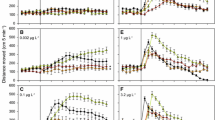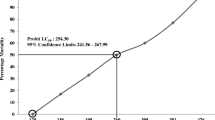Abstract
A series of laboratory (short-term exposure in small beakers) studies and a 19 d mesocosm (6 m3 polyethylene bags filled with fjord water) study were conducted on blue mussel, Mytilus edulis, larvae and plantigrades exposed to a concentration gradient of the detergent linear alkylbenzene sulphonate (LAS, 0 to 39 mg l−1). LAS is increasingly found in nearshore environments receiving wastewater from urban treatment plants. The aims were to observe physiological effects on swimming, grazing and growth in the laboratory and effects on settling and population development at in situ conditions (in field mesocosms) in order to evaluate the damages on ciliated meroplankton caused by LAS. In the laboratory the larvae showed a 50% mortality at 3.8 mg LAS l−1 after 96 h exposure whether or not food was provided. Additionally the swimming behaviour was affected at 0.8 mg LAS l−1 (i.e. a more compact swimming track, a smaller diameter of the swimming tracks, and reduced swimming speed). The larval particle grazing was reduced 50% at 1.4 mg LAS l−1. The specific growth rate of the larvae was reduced to half at 0.82 mg LAS l−1 over 9 d. During the mesocosm experiment, the larval population showed a dramatic decrease in abundance within 2 d at concentrations as low as 0.08 mg LAS l−1, both due to a significantly increased mortality, but also due to settling. The settling success was reduced at the same LAS concentration as that at which mortality was observed to increase significantly. In addition to reduced settling rate, the larvae showed delayed metamorphosis and reduced shell growth as a response to LAS. Our hypothesis that the larval ciliary apparatus, crucial for normal swimming, orientation, and settling behaviours and for particle uptake, was damaged due to LAS exposure is supported by our results. This is confirmed by the physiological data (grazing, growth) and in the direct video-based observations of larval performance (swimming) and provides a reasonable explanation for what was observed in the bags (abundance, settling, mortality). These physiological effects on blue mussel larvae/plantigrades occurred at LAS concentrations reported to occur in estuarine waters.
Similar content being viewed by others
Author information
Authors and Affiliations
Additional information
Received: 15 January 1997 / Accepted: 12 February 1997
Rights and permissions
About this article
Cite this article
Hansen, B., Fotel, F., Jensen, N. et al. Physiological effects of the detergent linear alkylbenzene sulphonate on blue mussel larvae (Mytilus edulis) in laboratory and mesocosm experiments. Marine Biology 128, 627–637 (1997). https://doi.org/10.1007/s002270050129
Issue Date:
DOI: https://doi.org/10.1007/s002270050129




